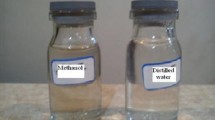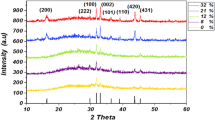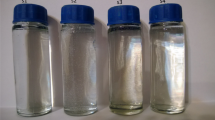Abstract
Pulsed laser ablation in liquid was employed to synthesize zinc oxide (ZnO) nanocolloidal suspension. Colloidal ZnO nanocrystals are synthesized by pulsed laser ablation of high purity zinc target in double distilled water with various laser fluences at RT. UV–visible absorption and transmission electron microscope are used for the characterization of colloidal ZnO nanoparticles (NPs). The optical properties, size, and the morphology of the synthesized ZnO were influenced strongly by laser fluence and wavelength. The use of water gave spherical ZnO NPs with average size 35 nm. The optical band gaps of the ZnO NPs are increased with laser fluence up to 22.3 J/cm2.
Similar content being viewed by others
Avoid common mistakes on your manuscript.
Introduction
Zinc oxide (ZnO) is a promising material for optoelectronic devices (photodetector, Schottky diodes FET) and light-emitting devices due to a wide band gap (3.37 eV) and to large excitation binding energy (60 meV) at RT (Johnson et al. 2002).
Various method were employed to synthesize ZnO nanoparticles (NPs), including thermal evaporation, Sol–gel, spray pyrolysis, MBE, CVD, MOVP, magnetic sputtering and pulsed laser deposition (Singh et al. 2005; Wang et al. 2003; Haase et al. 1988; Chen et al. 1998; Gorla et al. 1999; Agashe et al. 2004; Ismail et al. 2007).
Pulsed laser ablation in liquid (PLAL) has attached much attention in production of nano-ZnO through irradiation of Zn target in liquid with high energy laser pulses (Sasaki et al. 2006; He et al. 2008; Singh and Gopal 2008). Thus technique is simple, inexpensive, required minimum amount of chemical species and high control on ablation atmosphere. Furthermore, this technique is useful for high purity ZnO NPs because only Zn target and water were used for preparation (Ishikawa et al. 2006).
In this paper, we have reported synthesis of ZnO NPs by nanosecond Nd:YAG laser ablation of zinc target immersed in distilled water at RT. The optical properties and morphology of colloidal ZnO NPs prepared at different laser conditions are investigated.
Materials and methods
Zinc oxide NPs were synthesized by pulsed laser ablation of zinc target in double distilled water (DDW) at room temperature. The zinc target (purity of 99.99% provided from Merck India co.) was fixed at bottom of glass vessel containing of 1 ml DDW. The ablation was achieved using focused output of pulsed Nd:YAG laser (type HUAFEI) operating with a repetition rate of 10 Hz and pulse width of 10 ns. Ablation is carried out with laser operating at 1,064 nm and 532 nm wavelengths at fluence set in the range of 8.7–39.6 J/cm2. The laser beam was focused on the Zn target using convex lens of 11 cm focal length to produce sufficient laser fluence for the ablation. The typical laser beam diameter on the target was varied in the range of 0.4–2.37 mm in diameter by changing the distance between the focusing lens and the Zn target. Figure 1 shows the experimental setup of PLAL system.
The optical absorbance in the UV–visible region of synthesized colloidal ZnO NPs was recorded using spectrophotometer (type Metratech). A drop of colloidal solution of ZnO NPs was placed on the colloidal coated copper grid after dried below the tungsten temperature.
The average particle size and amount of aggregation of NPs were characterized with a transmission electron microscope (TEM) type CM10 pw6020, Philips-Germany.
Results and discussion
Figure 2 displays the photograph of ZnO NPs prepared by laser fluence of 12.3 J/cm2. The dark yellow colloidal solution of ZnO NPs is obtained after laser irradiation of 50 pulses. UV–visible spectroscopy is one of the most widely used techniques for structural characterization of ZnO NPs.
Figure 3 shows UV–visible absorption spectra of ZnO NPs, immediately after ablation, prepared by different laser fluence. The absorption spectra have a sharp peaks centered approximately at 320 nm with a long tail towards long wavelength. This peak is the characteristic of ZnO formation. The tail is may be due to the scattering of a range of particle sizes and some type Urpach effect due to inter-grain depletion regions (Gondal et al. 2009). Increasing the laser fluence decreases the UV absorbance of ZnO NPs. The absorption coefficient α was estimated from absorbance data using the Lambert–Beer law.
The variation of (αhυ)2 with photon energy (hυ) is depicted in Fig. 4. The optical band gapEg of ZnO NP is determined from extrapolating the linear part of (αhυ)2 hυ plot on the X-axis. The optical gap found to be varied from 3.13 eV depending on the laser fluence.
The absorption peaks of ZnO NPs can be used to estimate the particle size (d) from the following effective mass approximation (Wong et al. 1998).
where ΔE is the shift in optical gap with respect to the bulk band gap (3.35 eV), \( \hbar \) is the Plank’s constant, and m* is the exciton reduced effective mass equal to 0.24 me. Table 1 lists the particle size as a function of laser fluence. Increasing the laser fluence leads to increases the particle size except for ZnO NPs ablated with 39.6 J/cm2. Actually, increasing laser fluence means delivering more energy implies ablating larger amount of material. It was noticed that increasing laser fluence produced plasma plume becomes more intense, see (Fig. 5) and the ZnO nanocolloidal particles could becomes denser. This gives an indication that bigger particles will be produced due to two facts. The first is due to longer growth time and the second fact is due to high probability of cluster aggregation. On the other hand, sound generated by breakdown of water was detected at high laser fluence. The bright spark of plasma plume was observed at high laser fluence (Fig. 5b). The absorption spectra of ZnO NPs prepared by 1,064 nm and 532 nm laser wavelengths are depicted in Fig. 6. The plot of (αhυ)2 versus hυ plot of ZnO NPs prepared with different two wavelengths (1,064 and 532 nm) of Nd:YAG laser at same fluence is shown Fig. 7. The optical band gap of ZnO NPs produced by 532 nm laser wavelength was 3.23 eV and it was 3.32 eV for ZnO NPs synthesized by 1,064 nm laser wavelength. These results are agreed well with those reported by Thareja and Shukia (2007). The estimated particle sizes of ZnO are 36 and 88 nm when ablated with 1,064 and 532 nm lasers, respectively.
Transmission electron microscope analysis as shown in Fig. 8a exhibits spherical with size distribution centered at 30 nm (FWHM = 20 nm) for ZnO NPs prepared with 532 nm Nd:YAG laser. Figure 8b shows the size distribution of ZnO spherical NPs centered at 40 nm (FWHM = 25 nm) produced by 1,064 nm Nd:YAG laser pulses. It is noticed from the Fig. 8, the size distribution of ZnO NPs is nearly Gaussian type. The image of TEM shows agglomerates of small grain of some dispersed ZnO NPs. It is noticed that the solution containing ZnO NPs is stable for 2 months at R.T if stored in a covered glass container.
Conclusion
In summary, we successfully demonstrated the synthesis of high purity ZnO NPs colloid at room temperature by Nd:YAG laser ablation of Zn target in water. The optical properties of ZnO are strongly affected by laser fluence and wavelength. The ZnO NPs exhibited high absorption in UV region and lowered absorption in visible and IR regions. The average size of ZnO NPs increased with laser fluence. The synthesized ZnO NPs have spherical shape and the size distribution is nearly Gaussian. The effect of water temperature on characteristics of ZnO NPs is underway.
References
Agashe C, Kluth O, Hupkes J, Zastrow U, Rech B, Wuttig M (2004) Efforts to improve carrier mobility in radio frequency sputtered aluminum doped zinc oxide films. J Appl Phys 95:1911
Chen Y, Bangall D, Koh H, Park K, Hiraga K, Zhu Z, Yao T (1998) Plasma assisted molecular beam epitaxy of ZnO on c-plane sapphire: growth and characterization. J Appl Phys 84:3912
Gondal M, Drmosh Q, Yamani Z, Saleh T (2009) Synthesize of ZnO2 nanoparticles by laser ablation in liquid and their annealing transformation into ZnO nanoparticles. Appl Surf Sci 256:298
Gorla C, Emanetoglein N, Liang S, Mayo W, Lu Y, Wrabagk M, Shen H (1999) Structural, optical, and surface acoustic wave properties of epitaxial ZnO films grown on (0112) sapphire by metal organic chemical vapor deposition. J Appl Phys 85:2595
Haase AM, Weller H, Henglein A (1988) Photochemistry and radiation chemistry of colloidal semiconductors: 23. Electron storage on zinc oxide particles and size quantization. J Phys Chem 92:482
He C, Sasaki T, Shimizu Y, Koshizaki N (2008) Synthesis of ZnO nanoparticles using nanosecond pulsed laser ablation in aqueous media and their self-assembly towards spindle-like. Appl Surf Sci 25:42196
Ishikawa Y, Shimizu Y, Sasaki T, Koshizaki N (2006) Preparation of zinc oxide nanorods using pulsed laser ablation in water media at high temperature. J Colloid Interf Sci 300:612
Ismail RA, Rasheed BG, Salm ET, Al-Hadethy M (2007) Transparent and conducting ZnO films prepared by reactive pulsed laser deposition. J Mater Sci: Mater Electron 18:397
Johnson J, Yan H, Schaller R, Petersen P, Yang P, Saykally R (2002) Near-field imaging of nonlinear optical mixing in single zinc oxide nanowires. Nano Lett 279:2
Sasaki T, Shimizu Y, Koshizaki N (2006) Preparation of metal oxide-based nanomaterials using nanosecond pulsed laser ablation in liquids. J Photochem Photobiol A: Chem 182:335
Singh S, Gopal R (2008) Synthesis of colloidal zinc oxide nanoparticles by pulsed laser ablation in aqueous media. Physica E 40:724
Singh J, Srivasatva A, Tiwari R, Srivastava O (2005) Nucleation and growth of catalyst-free zinc oxide nanostructures. J Nanosci Nanotechnol 2093:5
Thareja R, Shukia S (2007) Synthesis and characterization of zinc oxide nanoparticles by laser ablation of zinc in liquid. Appl Surf Sci 253:8889
Wang Z, Zhang H, Zhang L, Yuan J, Wang C (2003) Low-temperature synthesis of ZnO nanoparticles by solid-state. Nanotechnology 11:14
Wong E, Bonevich J, Searson P (1998) Growth kinetics of Nanocrystalline ZnO particles from colloidal suspensions. J Phys Chem B 102:7770
Open Access
This article is distributed under the terms of the Creative Commons Attribution License which permits any use, distribution, and reproduction in any medium, provided the original author(s) and source are credited.
Author information
Authors and Affiliations
Corresponding author
Rights and permissions
Open Access This article is distributed under the terms of the Creative Commons Attribution 2.0 International License (https://creativecommons.org/licenses/by/2.0), which permits unrestricted use, distribution, and reproduction in any medium, provided the original work is properly cited.
About this article
Cite this article
Ismail, R.A., Ali, A.K., Ismail, M.M. et al. Preparation and characterization of colloidal ZnO nanoparticles using nanosecond laser ablation in water. Appl Nanosci 1, 45–49 (2011). https://doi.org/10.1007/s13204-011-0006-3
Received:
Accepted:
Published:
Issue Date:
DOI: https://doi.org/10.1007/s13204-011-0006-3












